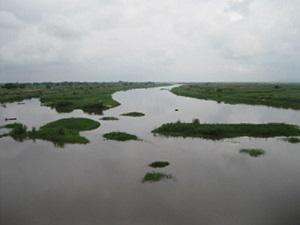Katya Abrantes
This study aims to determine the importance of terrestrial material that is transported laterally with the flood waters as a source of nutrition for aquatic animal communities in the Zambezi River and Estuary.

Zambezi River floodplain around Caia, in an area dominated by grasses. Most dryland grasses are C4 plants characterised by high δ13C values, very different to those of aquatic producers such as plankton and benthic microalgae.
In Mozambique, human populations inhabiting the Zambezi floodplain depend strongly on agriculture and artisanal fisheries. However, despite the socio-economic importance of the area, destructive activities such as deforestation are in rapid ascent, threatening the waterway and its wetlands. The construction of a new dam, the Mpanda Nkuwa will also start in 2012, and will have serious consequences for both human and animal populations. There is therefore a pressing need to identify the effects of these destructive activities over aquatic communities before this additional impact is implemented, to provide baseline ecological information that can be later used for comparison with the situation after impact.

Fishermen working in Cahora Bassa reservoir, illustrating the dominance of C3 vegetation (trees) in the surrounding area. C3 plants have typically low δ13C values, relatively similar to those of freshwater aquatic producers (e.g. plankton).
The main objective of this study is to quantify the importance of terrestrial material transported laterally into waterways with the floods for aquatic foodwebs, so that different human impacts (flow regulation, deforestation, urbanisation) can be measured and predicted. An input of terrestrial material represents a link between the terrestrial and aquatic environments. Understanding this link is crucial to predict the impacts of the different human activities and must be taken into account in projects that involve the alteration of hydrology and connectivity regimes of rivers or the modification of wetlands and adjacent habitats.
This project is based on stable isotope (SI) analysis (carbon, nitrogen, sulphur, hydrogen). This biogeochemical technique is useful in foodweb studies because different primary producers can have different SI composition, and because the SI composition of a consumer reflects its food source. Thus, SI can be used to identify sources of nutrition and describe trophic organization and trophic pathways from producers through to high trophic level animals. Four sites along the Zambezi River are considered: Chinde (estuary), Marromeu, Sena/Mutarara and Cahora Bassa reservoir. These sites drain areas with terrestrial vegetation characterized by different δ13C throughout the catchment (C3 vs. C4) and by different adjacent land-use, allowing foodweb characteristics to be linked to the different environmental conditions. Sites will be sampled before and after the wet season to identify any seasonal variability in sources of nutrition and the importance of the preservation of natural flood regimes. Data will be combined with that collected in systems in Australia, Madagascar and Kenya to multiply the potential to detect general patterns and successfully attribute causalities. Results will contribute for the formulation of appropriate guidelines regarding land-use and flow management, providing a basis for the development of rational river and wetland conservation and management priorities for the Zambezi River.